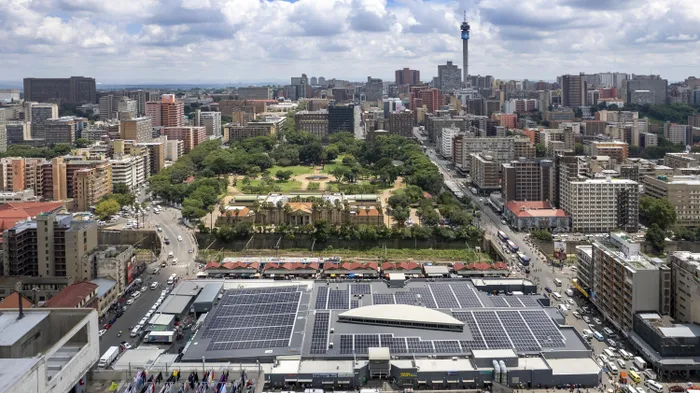Real estate company generates 100 million kilowatt-hours of renewable energy: a milestone in sustainability

The real estate company recently installed a further 37 solar photovoltaic (PV) plants across its portfolio, marking an increase of 62.7% from the prior year.
Image: Supplied
The generation of 100 million kilowatt-hours (kWh) of renewable energy by Fortress Real Estate Investments since the launch of its first rooftop solar photovoltaic (PV) installation in 2017 spells a sustainability milestone.
Fortress, South Africa's largest real estate company with a growing footprint across Central and Eastern Europe (CEE), says this total output, equivalent to 100 gigawatt-hours (GWh), reflects its commitment to sustainability, energy resilience, and operational efficiency.
“This is a major accomplishment for Fortress,” says PC Potgieter, head of sustainability. “Our strategy is about more than solar installations. It’s about building an environmentally friendly, efficient, and cost-effective operational model that supports tenants and enhances shareholder value.”
For context, the company, which has a portfolio of logistics properties in South Africa and Central and Eastern Europe valued at R20.3 billion and a portfolio of retail properties of R10.7 billion, all located in South Africa, says this volume of clean energy could power approximately 9 000 urban homes or 28 000 rural homes for a whole year.
Since the programme began, 9.310 solar panels and 401 inverters have been installed.
The area covered by these panels is 205 000m², the equivalent of 30 rugby fields, and represents almost one-third of Fortress’s total retail portfolio GLA, the company says.
As at 30 June this year, Fortress says it operates 96 solar PV systems, including sites in Poland and Romania, with a total installed capacity of 35.49 MWac. By December 2025, it says it aims to add a further 10 plants, taking the total number of installations to 106 with an installed capacity of 37.71 MWac.
Renewable energy penetration is estimated to increase from 18% currently to 24% by June next year.
“Solar remains the biggest element in our energy strategy,” adds Potgieter. “It’s not only a cost saver but also a strategic buffer against grid instability and rising electricity tariffs.”In addition to solar, back-up generators have been installed at 32 retail centres, with a further 3 centres planned for installations by June next year.
Utilities management
The real estate company says it is also transforming utilities management through smart metering and in-house data platforms.
Smart meters have been installed at 79% of the retail portfolio (30 centres), and another three centres are planned for installation by June next year. These meters are said to offer near real-time data on consumption and energy mix (grid, solar, diesel), enabling operational benchmarking and efficiency gains
The smart metering is managed entirely in-house, giving Fortress full control of data, faster decision-making, and tenant-friendly digital dashboards.
Water resilience
To complement its energy strategy, Fortress says it is investing heavily in water resilience with 30 retail centres now featuring backup tanks providing up to three days of water during outages. Some 14 properties are supported by on-site borehole systems.
Innovative water-saving technologies, including Propelair toilets, have been successfully piloted to reduce consumption at malls. These will now be rolled out at further selected assets.
Potgieter highlights that, “the associated water saving, which we estimate to be in the order of 135 000kl is enough to sustain 375 houses for a year.”
The company says its renewable reach extends beyond its own rooftops. It says that in 2024, the company signed a 10-year wheeling agreement with Discovery Green, effective from the last quarter of next year.
It says this will supply clean energy to 14 Eskom-supplied Fortress properties, covering at least 70% (and up to 100%) of electricity demand not met by on-site solar systems.
“This is a critical step in reaching our 2030 decarbonisation target of reducing our Scope 1, 2 and 3 carbon footprint by 45% compared to our 2018 baseline,” says Potgieter.
Regarding Battery Energy Storage Systems (BESS), the head of sustainability says they see stronger business cases for BESS solutions following the recent reduction in battery costs and tariff increases.
“These business cases remain sensitive to load profiles and in force tariff structures. Battery systems are preferred for refinement of returns based on time of use tariffs, rather than for back-up power, for which generators are favoured,” explains Potgieter.
Currently, a number of feasibility studies are being conducted, and Fortress has commenced with three BESS installations.
With much of the infrastructure now in place, Fortress says it is shifting focus from installation to optimisation: “It’s not just about how much solar we’ve installed,” Potgieter says.
“It’s about how effectively we manage the systems we’ve built. We’re saving money, reducing risk, and improving our environmental footprint. That’s good for our tenants, our communities, and ultimately, our shareholders.”
SA investment property performance
Meanwhile, the MSCI SA Biannual Property Index (Unfrozen) for H1 2025 shows that South Africa’s investment property has delivered the strongest performance in eight years.
This index, which measures unlevered total returns of directly held property investments from one valuation to the next, tracked the performance of 1 639 property investments with a total capital value of R394.2 billion as at June this year.
It shows that SA investment property delivered a total return of 5.3% for the period, comprising an income return of 4.1% and positive capital growth of 1.1%.
The improvement in capital values was said to be supported by steady base rental growth of 4.6% while the overall vacancy rate edged up only marginally to 7% from 6.5% at the end of last year.
Independent Media Property
Related Topics: